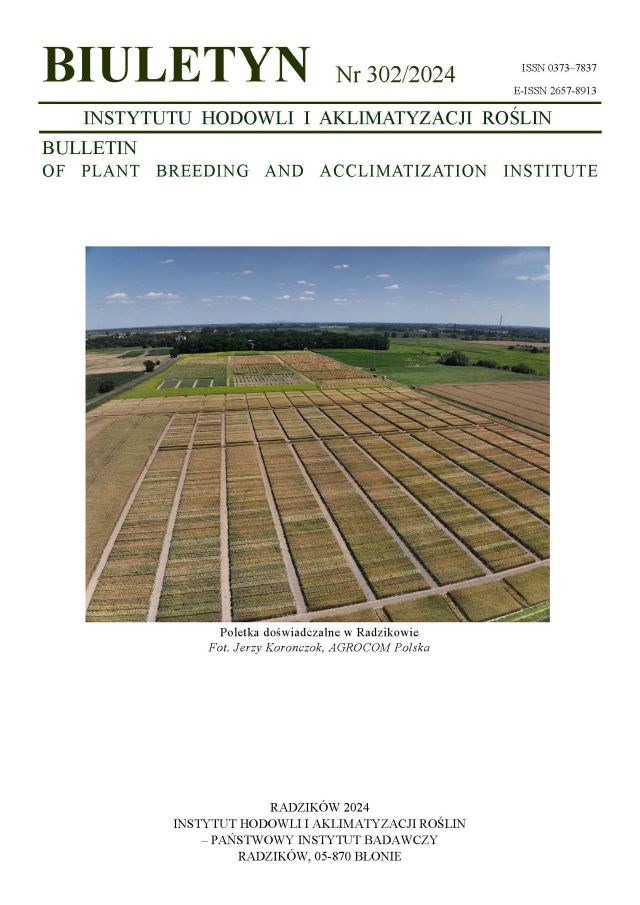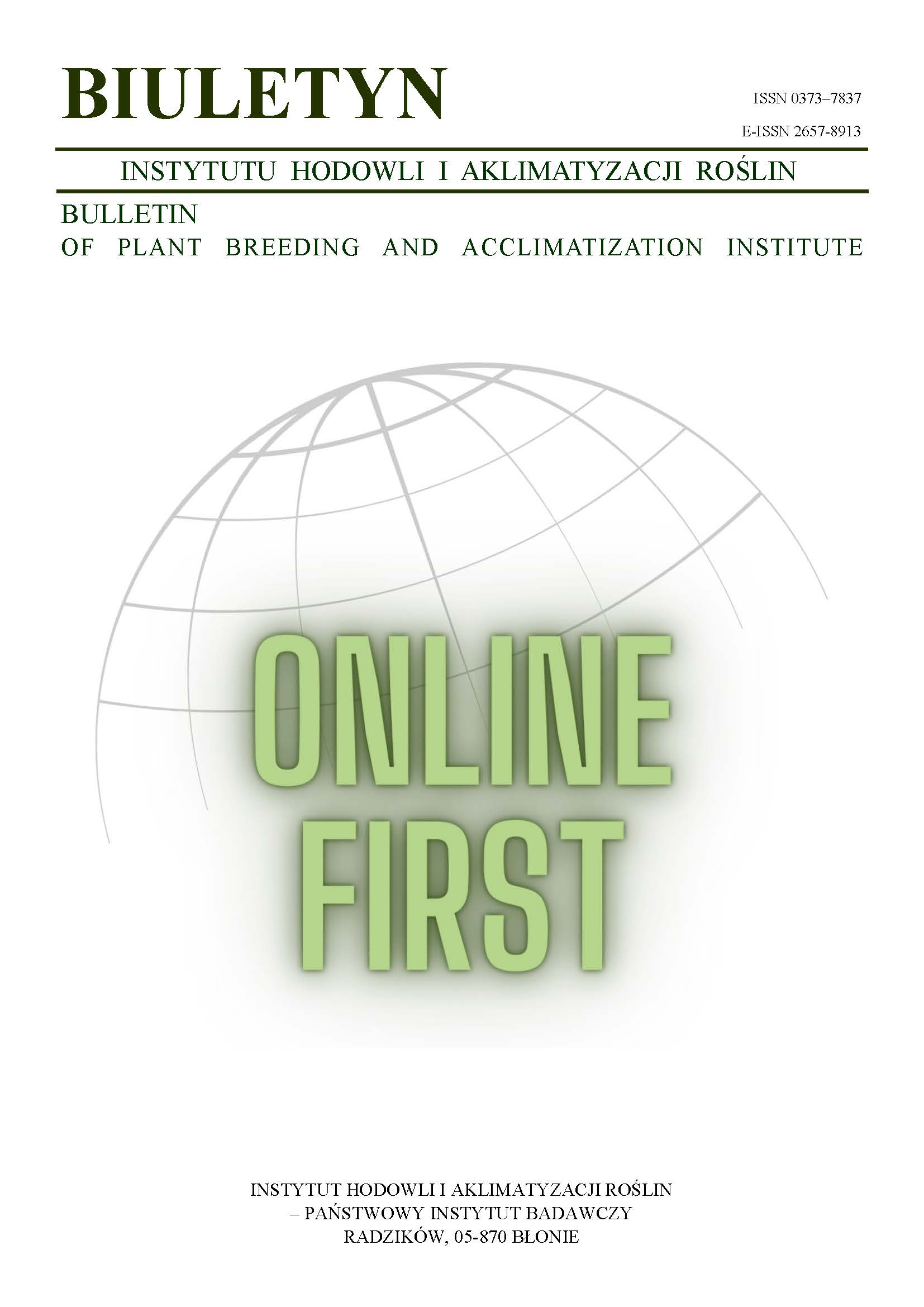The use of marker-assisted selection for introduction of leaf rust resistance gene Lr50 (Puccinia recondita f. sp. tritici) to wheat
Paweł Cz. Czembor
p.czembor@ihar.edu.plInstytut Hodowli i Aklimatyzacji Roślin, Radzików (Poland)
Aleksandra Pietrusińska
Instytut Hodowli i Aklimatyzacji Roślin, Radzików (Poland)
Abstract
The leaf rust resistance gene Lr50 was introduced to the wheat variety Flair using marker-assisted selection strategy. Two backcrosses to the recurrent parent were performed. Two microsatellites gwm382 and gdm87 flanking gene Lr50 were used to select individuals with the resistance gene in offspring populations. In addition, recipient genome content was evaluated on F1BC1 population using a set of 21 microsatellite markers. Therefore, in the centromer region of each chromosome one marker was located. Unfortunately, due to the lack of DNA polymorphism or absence of expected PCR products, the information obtained was limited. Nevertheless, the marker-assisted selection strategy allowed to select lines carrying gene Lr50. The lines were transferred to the wheat breeding program focused on the resistance to leaf rust.
Keywords:
leaf rust, marker-assisted selection, resistance, wheatReferences
Brown-Guedira G. L., Gill B. S., Cox T. S., Leath S. 1997. Transfer of disease resistance genes from Triticum araraticum to common wheat. Plant Breeding 116: 105 — 112.
DOI: https://doi.org/10.1111/j.1439-0523.1997.tb02162.x
Google Scholar
Brown-Guedira G. L., Singh S., Fritz A. K. 2003. Performance and mapping of leaf rust resistance transferred to wheat from Triticum timopheevii subsp. armeniacum. Phytopathology 93: 784 — 789.
DOI: https://doi.org/10.1094/PHYTO.2003.93.7.784
Google Scholar
COBORU. 2004. Lista opisowa odmian, COBORU, Słupia Wielka. Część I. Rośliny rolnicze zbożowe i przemysłowe: 34 s.
Google Scholar
Dubcovsky J. 2004. Marker-assisted selection in public breeding programs: the wheat experience. Crop Science 44: 1895 — 1898.
DOI: https://doi.org/10.2135/cropsci2004.1895
Google Scholar
Eagles H. A., Bariana H. S., Ogbonnaya F. C., Rebetzke G. J., Hollamby G. J., Henry R. J., Henschke P. H., Carter M. 2001. Implementation of markers in Australian wheat breeding. Aust. J. Agric. Res. 52: 1349 — 1356.
DOI: https://doi.org/10.1071/AR01067
Google Scholar
Helguera M., Khan I. A., Dubcovsky J. 2000. Development of PCR markers for wheat leaf rust resistance gene Lr46. Theor. Appl. Genet. 100: 1137 — 1143.
DOI: https://doi.org/10.1007/s001220051397
Google Scholar
Huang L., Gill B. S. 2001. An RGA-like marker detects all known Lr21 leaf rust resistance gene family members in Aegilops tauschii and wheat. Theor. Appl. Genet. 103: 1007 — 1013.
DOI: https://doi.org/10.1007/s001220100701
Google Scholar
Knott D. R. 1989. The wheat rusts: breeding for resistance. Monographs on Theoretical and Applied Genetics 12. Springer, Berlin.
DOI: https://doi.org/10.1007/978-3-642-83641-1
Google Scholar
Koebner R. M. D., Summers R. W. 2003. 21st century wheat breeding: plot selection or plate detection? Trends in Biotechnology 21 (2): 59 — 63.
DOI: https://doi.org/10.1016/S0167-7799(02)00036-7
Google Scholar
Langridge P., Lagudah E. S., Holton T. A., Appels R., Sharp P. J., Chalmers K. J. 2001. Trends in genetic and genome analyses in wheat: a review. Aust. J. Agric. Res. 52: 1043 — 1077.
DOI: https://doi.org/10.1071/AR01082
Google Scholar
McIntosh R. A., Hart G. E., Devos K. M., Gale M. D., Rogers W. J. 1998. Catalogue of gene symbols for wheat. In: Slinkard A. E. (ed.). Proc. 9th Int. Wheat Genet Symp. 5: 13–72. Univ. Extension Press. Univ. of Saskatchewan. Saskatoon.
Google Scholar
McIntosh R. A., Wellings C. R., Park R. F. 1995. Wheat rusts: an atlas of resistance genes. CSIRO Australia/ Kluwer Academic Publishers, Dordrecht, The Netherlands.
DOI: https://doi.org/10.1071/9780643101463
Google Scholar
Pestsova E., Ganal M. W., Röder M. S. 2000. Isolation and mapping of microsatellite markers specific for the D genome of bread wheat. Genome 43: 689 — 697.
DOI: https://doi.org/10.1139/gen-43-4-689
Google Scholar
Raupp W. J., Sukhwinder-Singh, Brown-Guedira G. L., Gill B. S. 2001. Cytogenetic and molecular mapping of the leaf rust resistance gene Lr39 in wheat. Theor. Appl. Genet. 102: 347 — 352.
DOI: https://doi.org/10.1007/s001220051652
Google Scholar
Ribaut J. M., Hoisington D. 1998. Marker-assisted selection: new tools and strategies. Trends in Plant Science 3 (6): 236 — 239.
DOI: https://doi.org/10.1016/S1360-1385(98)01240-0
Google Scholar
Röder M. S., Korzun V., Wendehake K., Plaschke J., Tixier M. H., Leroy P., Ganal M. W. 1998. A microsatellite map of wheat. Genetics 149: 2007 — 2023.
DOI: https://doi.org/10.1093/genetics/149.4.2007
Google Scholar
Roelfs A. P., Singh R. P., Saari E. E. 1992. Rust Disease of Wheat. Concepts and methods of disease management. Mexico, D.F. CIMMYT: 81 p.
Google Scholar
Servin B., Hospital F. 2002. Optimal positioning of markers to control genetic background in marker assisted backcrossing. The Journal of Heredity 93 (3): 214 — 217.
DOI: https://doi.org/10.1093/jhered/93.3.214
Google Scholar
Winzeler M., Mesterházy A., Park R. F., Bartoš P., Csösz M., Goyeau H., Ittu M., Jones E., Löschenberger F., Manninger K., Pasquini M., Richter K., Rubiales D., Schachermayr G., Strzembicka A., Trottet M., Unger O., Vida G., Walther U. 2000. Resistance of European winter wheat germplasm to leaf rust. Agronomie 20: 783 — 792.
DOI: https://doi.org/10.1051/agro:2000175
Google Scholar
Authors
Paweł Cz. Czemborp.czembor@ihar.edu.pl
Instytut Hodowli i Aklimatyzacji Roślin, Radzików Poland
Authors
Aleksandra PietrusińskaInstytut Hodowli i Aklimatyzacji Roślin, Radzików Poland
Statistics
Abstract views: 126PDF downloads: 27
License
Copyright (c) 2005 Paweł Cz. Czembor, Aleksandra Pietrusińska

This work is licensed under a Creative Commons Attribution-ShareAlike 4.0 International License.
Upon submitting the article, the Authors grant the Publisher a non-exclusive and free license to use the article for an indefinite period of time throughout the world in the following fields of use:
- Production and reproduction of copies of the article using a specific technique, including printing and digital technology.
- Placing on the market, lending or renting the original or copies of the article.
- Public performance, exhibition, display, reproduction, broadcasting and re-broadcasting, as well as making the article publicly available in such a way that everyone can access it at a place and time of their choice.
- Including the article in a collective work.
- Uploading an article in electronic form to electronic platforms or otherwise introducing an article in electronic form to the Internet or other network.
- Dissemination of the article in electronic form on the Internet or other network, in collective work as well as independently.
- Making the article available in an electronic version in such a way that everyone can access it at a place and time of their choice, in particular via the Internet.
Authors by sending a request for publication:
- They consent to the publication of the article in the journal,
- They agree to give the publication a DOI (Digital Object Identifier),
- They undertake to comply with the publishing house's code of ethics in accordance with the guidelines of the Committee on Publication Ethics (COPE), (http://ihar.edu.pl/biblioteka_i_wydawnictwa.php),
- They consent to the articles being made available in electronic form under the CC BY-SA 4.0 license, in open access,
- They agree to send article metadata to commercial and non-commercial journal indexing databases.
Most read articles by the same author(s)
- Aleksandra Pietrusińska, Monika Żurek, Dariusz Mańkowski, The search for sources of biotic stress resistance in old varieties and landraces of wheat and triticale , Bulletin of Plant Breeding and Acclimatization Institute: No. 287 (2019): Special issue
- Aleksandra Pietrusińska, Monika Żurek, The impact of powdery mildew on cereals and grasses on wheat crops in the context of climate change , Bulletin of Plant Breeding and Acclimatization Institute: No. 301 (2024): Regular issue
- Aleksandra Pietrusińska, Jerzy H. Czembor, Gene pyramiding — a tool commonly used in breeding programs breeding programs , Bulletin of Plant Breeding and Acclimatization Institute: No. 278 (2015): Regular issue
- Aleksandra Pietrusińska, Jerzy H. Czembor, Virulence structure of the Blumeria graminis f. sp. tritici population occurring in Poland across 2012–2013 , Bulletin of Plant Breeding and Acclimatization Institute: No. 274 (2014): Regular issue
- Aleksandra Pietrusińska , Pyramiding efficiency of the genes of resistance to powdery mildew (Blumeria graminis f.sp. tritici) and brown rust (Puccinia triticina) in winter wheat , Bulletin of Plant Breeding and Acclimatization Institute: No. 286 (2019): Special issue
- Paweł Cz. Czembor, Dariusz Mańkowski, Piotr Słowacki, Dominika Piaskowska, Association mapping for resistance genes to leaf rust (Puccinia triticina) and Septoria tritici blotch (Septoria tritici) in wheat , Bulletin of Plant Breeding and Acclimatization Institute: No. 286 (2019): Special issue
- Jerzy Czembor, Aleksandra Pietrusińska, Kinga Smolińska, Interaction between powdery mildew (Blumeria graminis f.sp. hordei) resistance determined by mlo gene and economical value characteristics in winter barley , Bulletin of Plant Breeding and Acclimatization Institute: No. 286 (2019): Special issue
- Jerzy H. Czembor, Aleksandra Pietrusińska, Urszula Piechota, Hordeum bulbosum — as a source of effective resistance to barley leaf rust , Bulletin of Plant Breeding and Acclimatization Institute: No. 281 (2017): Regular issue
- Jerzy H. Czembor, Olga Doraczyńska, Aleksandra Pietrusińska, Henryk J. Czembor, Resistance to powdery mildew (Blumeria graminis f. sp. hordei) in barley cultivars included to registration trials in Poland in 2012 , Bulletin of Plant Breeding and Acclimatization Institute: No. 268 (2013): Regular issue
- Aleksandra Pietrusińska, Paweł Cz. Czembor, Evaluation of selected DNA isolation methods for wheat breeding purposes , Bulletin of Plant Breeding and Acclimatization Institute: No. 244 (2007): Regular issue














